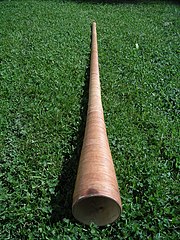
Back Lur (instrument) Catalan Lur Danish Lure (Blasinstrument) German Lur Spanish Lur (musika tresna) Basque Lur Finnish Lur (instrument) French Lur Hungarian Lur ID Lur (strumento musicale) Italian
This article needs additional citations for verification. (June 2011) |


A lur, also lure or lurr, is a long natural blowing horn without finger holes that is played with a brass-type embouchure. Lurs can be straight or curved in various shapes. The purpose of the curves was to make long instruments easier to carry (e.g. for marching, like the modern sousaphone) and to avoid directing the loud noise at nearby people.
The name lur is used for two distinct types of ancient wind instruments. The more recent type is made of wood and was in use in Scandinavia during the Middle Ages. The older type, named after the more recent type, is made of bronze, dates to the Bronze Age and was often found in pairs, deposited in bogs, mainly in Denmark and Germany. It consists of a mouthpiece and several pieces and/or pipes. Its length can reach between 1.5 and 2 metres. It has been found in Norway, Denmark, South Sweden, and Northern Germany. Illustrations of lurs have also been found on several rock paintings in Scandinavia.
- ^ "Bronze lurs - The Brudevælte lurs". Archived from the original on 2011-09-27. Retrieved 2007-10-21.